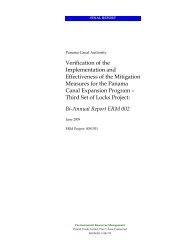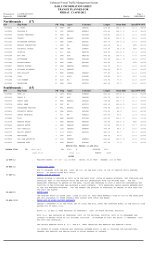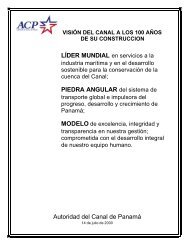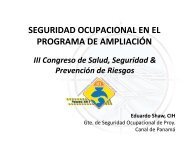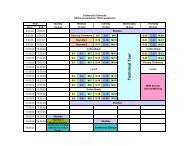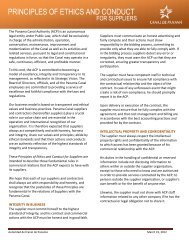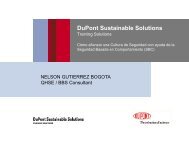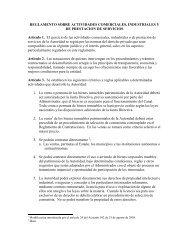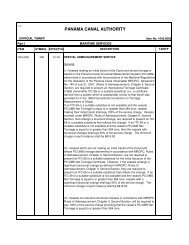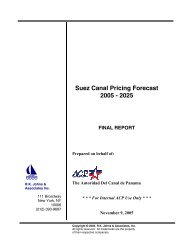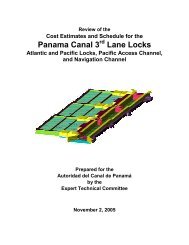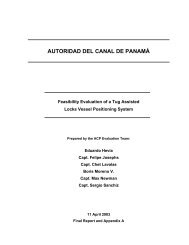RFI-ENGAGEMENT SERVICES FOR ... - Canal de Panamá
RFI-ENGAGEMENT SERVICES FOR ... - Canal de Panamá
RFI-ENGAGEMENT SERVICES FOR ... - Canal de Panamá
Create successful ePaper yourself
Turn your PDF publications into a flip-book with our unique Google optimized e-Paper software.
<strong>RFI</strong>-<strong>ENGAGEMENT</strong> <strong>SERVICES</strong> <strong>FOR</strong> ENTERPRISE ARCHITECTURE PROGRAM AND IMPLEMENTATION<br />
Shipping No. 1, Section 2 - Approval of Plans, and the Maritime Regulations for the<br />
Operations of the Panama <strong>Canal</strong>. This advance information will minimize the possibility<br />
that transit might be <strong>de</strong>nied due to noncompliance with <strong>Canal</strong> regulations.<br />
Before arriving to <strong>Canal</strong> waters and staying in the shipyard, ship owners of new/<br />
modified vessels are encourage to send their structural plans (e.g. general<br />
arrangements, visibility arrangements, capacity plan, engine room plan) for evaluation<br />
by ACP via email or by regular mail in a compact disk in PDF or TIFF file format or in a file<br />
format compatible with AUTOCAD in a compressed zip file. As part of this evaluation,<br />
the Naval Architect will review and validate the vessel’s plans and will certify if the<br />
new/modified vessel complies with the ACP’s Vessel Requirements (e.g. proper location,<br />
size, and height for the pilot shelter/platform). If the vessel’s plans comply, the<br />
documentation is stamped electronically with an “approved” seal and returned via email<br />
to allow the recipient controls of printing any number of copies of the stamped plans<br />
nee<strong>de</strong>d to meet distribution requirements; otherwise, a list of exceptions is sent to the<br />
owner in or<strong>de</strong>r to make the adjustments and correct the unsuitable or unsafe<br />
arrangements before the vessel leaves the shipyard.<br />
The Naval Architect scans the vessel’s plans (drawings and letters) and stores them<br />
insi<strong>de</strong> the document management system (DMS), classifying them by plan number, hull<br />
number and buil<strong>de</strong>r’s shipyard information. Even though the EVTMS system<br />
implemented a module for the Naval Architect to record this information in the system,<br />
currently the information is only stored off-line.<br />
Used software and tools: AutoCad, Microsoft Office (Outlook, Excel), FileNet (DMS),<br />
Telephone / Fax<br />
Fissile Material Cargo procedures<br />
Vessels carrying fissile material cargo are regulated by the Chapter 9, Article 137 of the<br />
Maritime Regulations for the Operations of the Panama <strong>Canal</strong>. These rules established<br />
that any vessel carrying fissile material cargo (e.g. Uranium, Plutonium) are required to<br />
provi<strong>de</strong> at least 30 days prior to arrival the following information:<br />
Criticality In<strong>de</strong>x according to the IMDG<br />
Certificate Package <strong>de</strong>sign<br />
Insurance Coverage<br />
Required Visit information (e.g. the cargo manifest).<br />
All this information is mailed to the ACP’s Dangerous Cargo Specialist who will<br />
review/revise all the documentation. There is a manual entry in an Excel control sheet<br />
to keep track of the information received.<br />
Non-binding <strong>RFI</strong> (Request for Information) 52 ACP RENOVA Program



